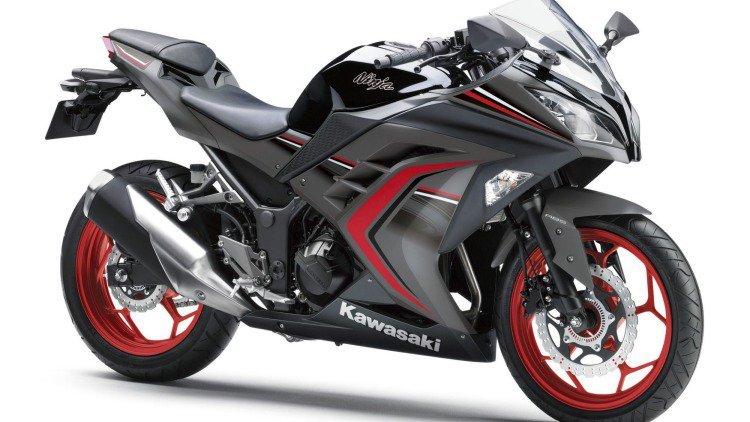
Kawasaki's Ninja 300 has a simple sales pitch.
It's affordable, sharp-looking, entertaining and accessible to new riders, a combination of factors that makes it the most popular new motorcycle in Australia.
There are a lot of benefits to motorcycling – it's cheaper than driving, plenty of fun and a great way to beat the traffic. The lifestyle's appeal isn't hurt by the indisputable fact that bikes are cool, with a visual and cultural pull that tempts many new riders.
The Ninja 300 draws on this with styling derived from the brand's fearsome four-cylinder superbikes, using pumped-up bodywork, focused styling and sharp graphics to cash in on the appeal of track-honed machines.
Kawasaki says the 300's looks are inspired by more powerful members of the Ninja family, using a sharp front end and oversized exhaust silencer to look like "big Ninja models".

The Kawasaki Ninja 300 features ABS and a slipper clutch to help keep riders in control. Photo: Supplied
It also has the high and slim rear end of a modern sport bike, a clever floating windscreen and tidy Y-spoke 17-inch wheels that take inspiration from the brand's ZX-14 flagship.
The effect is an attractive offering that can easily be confused for full-strength performance bikes – at least by people outside the motorcycle community.
Kawasaki's new-for-2016 "graystone" test scheme of our test bike blends charcoal and black tones with red wheels and graphic elements that look striking, while riders after a more conventional look can have a red bike with black wheels.
Priced from $6399 plus on-road costs, the 2016 Ninja 300 ABS is $500 cheaper than last year's model – a move designed to counter sliding sales for the model.
The 2016 bike is only available in ABS form, but buyers on a budget can snap up 2015 non-ABS models from $5699 plus on-road costs.
This bike's single petal-shaped 290mm front disc joins a 220mm disc at the rear, both clamped by twin-piston calipers. Further safety is offered by a race-style slipper clutch that serves as a back-torque limiter, preventing the rear wheel from compression-locking under heavy braking or mistimed downshifts.
As before, the Ninja has a basic instrument cluster with an analogue tacho and clear digital speedometer, benefiting from revised illumination on the updated version that makes it easier to see at night. There's little data beyond that – a gear indicator or shift light would be welcome – though Kawasaki has seen fit to install an "Eco riding indicator" encouraging riders to keep the revs down and use small throttle openings.
Suspension is taken care of by fixed-rate 37mm front forks with fairly soft setup and a rear monoshock with five-step adjustability catering to riders of different sizes.
Kawasaki offers customers a handful of ways to customise their bikes, including a single-seat conversion that covers the pillion pad, a taller windscreen conversion and protective frame sliders.
Power comes from a 296cc parallel twin motor that complies with learner-legal requirements, adding to the bike's popularity.
The fuel injected eight-valve unit is capable of spinning out to 13,000rpm, though doing so isn't necessary as its 29kW of maximum power is on tap at 11,000rpm. With its 27Nm torque peak arriving at 10,000rpm, it's clear on paper that this is a bike that loves a rev.
The same is true on the road, where the little Ninja must be worked hard to deliver its best. That's no bad thing, as it is responsive and engaging, rewarding riders looking to extract all of its performance.
The decently chunky 140mm-wide rear tyre offers plenty of grip, and the slipper clutch does a good job of masking ham-fisted inputs. A somewhat spongy front brake lever is more forgiving than the razor-sharp response of race-replicas, though it requires increased effort compared with more precise rivals.
While it is fun to wring the Ninja's neck and play at being a Moto3 rider on a favourite stretch of road, new riders may eventually grow tired of the relatively tame performance on offer, particularly compared with larger and more expensive learner-legal alternatives.
Though the 17-litre fuel tank offers usable range, the Ninja is not at ease on longer rides thanks to a forward-pitched riding position that puts more weight over a rider's wrists than more upright alternatives, along with a buzzing engine which needs well more than 6000rpm on board to cruise at highway speeds.
But cruising is not what this bike is for.
The Ninja remains a stylish, cheap and fun way to enter the world of motorcycling, traits that should see it remain popular for years to come.
KAWASAKI NINJA 300 ABS PRICING AND SPECIFICATIONS
On sale: Now
Price: $6399 plus on-road costs
Engine: 296cc parallel twin
Power: 29kW at 11,000rpm
Torque: 27Nm at 10,000rpm
Transmission: Six-speed, chain drive
Fuel use: 3.5L/100km (approx.)
#introduceyourself/#introducemyself
The “introduceyourself/introducemyself” tag is for creating one introductory post that tells us about you. Users are encouraged to use this tag exclusively for that, and not to reuse it.
Hi! I am a robot. I just upvoted you! I found similar content that readers might be interested in:
https://www.drive.com.au/bike-reviews/kawasaki-ninja-300-review-why-this-is-australias-bestselling-bike-20151103-gkpczj